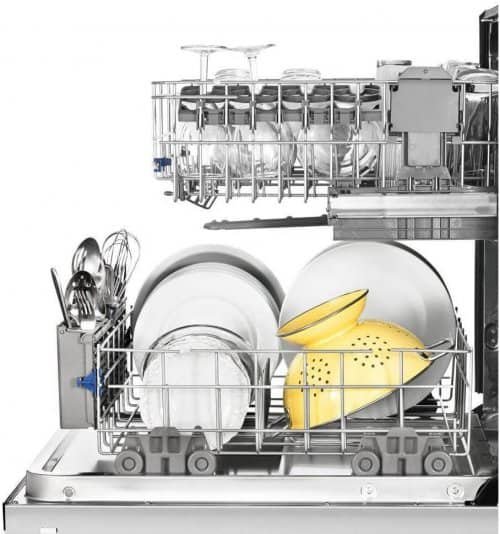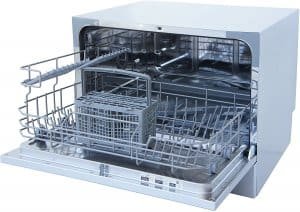Dishwashers are important with regards to cleaning dishes and cookware with a negligible part of the work of handwashing. Use this manual to figure out how to appropriately load and work a dishwasher, how to pick the right detergent and load it into the dishwasher, and which cycle to use to guarantee ideal performance.
Without any further adieu, let us hop right onto it.
Loading The Dishwasher:
Table of Contents
Step 1: Rinse Your Dishes
On the off chance that you simply throw dirty dishes in your dishwasher, they will not be squeaky clean. Prior to loading your dishes in the washer, run them under tap water from the sink to remove bits and pieces of the food, condiments, and different substances.
These dishes do not need to be totally cleaned before you place them in the sink. Notwithstanding, they need to be free from abundant food prior to washing.
Step 2: Load The Bottom Rack

On the bottom rack, load dishes like pots, containers, meal dishes, bowls, and plates. Ensure every one of your dishes faces the spray spout of your dishwasher. Angle everything down somewhat. This will help with guaranteeing a more intense cleaning.
You need to likewise load flatware in the flatware rack.
Flat pots and platters need to be put close to the back of the dishwasher.
Ensure stainless steel and silver dishes do not touch. Assuming that they contact during the wash, this can cause a chemical reaction that will harm your dishes.
Step 3: Load The Top Rack
Glasses and mugs go in the top rack. Place these face down in the dishwasher and point them however much as could reasonably be expected to get the inner parts washed.
While washing wine glasses, try to point them so they do not squirm in the washing machine. Wine glasses can break easily in the dishwasher.
It could be ideal to hand wash costly wine glasses.
Step 4: Use an Appropriate Amount of Detergent
You needn’t bother with a ton of detergent. An excessive amount of detergent can cause soap residue to adhere to dishes. Really look at your detergent’s label to know the amount to add. Try not to add more, regardless of whether your dishes are exceptionally dirty.
Use powder or liquid detergent rather than units. Powder and liquid detergents are clean and are more affordable than pods.
Step 5: Be Careful When Loading Plastics
Plastic things are lightweight and can move around effectively during the wash. Make a point to put them on racks that keep them secure. They shouldn’t squirm set up, as this can cause them to become ousted during the wash.
Step 6: Avoid Loading Certain Kinds of Products
Not all things are washed in the dishwasher. Forgo putting the accompanying things in a dishwasher:
Materials like wood, cast iron, pewter, real silver, and aluminum
Children’s glasses with designs
Non-Stick dishes
Costly dishes
How To Use a Dishwasher-Running The Dishwasher:
Step 1: Run the lightest cycle, if conceivable
To save water, you need to typically select the lightest cycle on your dishwasher. In the event that your dishes are not very dirty, you ought to clean them completely. The dishes you ordinarily use in the week for eating, drinking, and cooking might come out all on a light cycle.
Step 2: Choose a rather intense cycle for the dirtier dishes
Extremely dirty dishes, for example, those used for heavy cooking or baking, may require a more intense wash. Typically, changing from a light wash to an ordinary wash needs to tidy off the most build-up residue. Dishes with stains set in can be washed using a heavy wash. Oily dishes would profit from a high-temp wash.
Step 3: Let the dishes air dry
Skirting the dry cycle saves energy. Except if you want to use the dishes right away, let them air dry in the rack before taking them out.
How To Use a Dishwasher-Cleaning the Dishwasher:
Step 1: Clean the exterior
To begin, you need to clean off the outside of your dishwasher. This will eliminate things like spilled food and fingerprints. Plastic dishwashers ought to be cleaned down with a wipe and soapy water. Stainless steel dishwashers need to be cleaned down using a glass cleaner.
Assuming that you are using a glass cleaner, do not spray it directly on the dishwasher. Dampness can cause damage to electronic wires. Apply the glass cleaner to a paper towel or a cloth first and afterward use that to clear off smircesh, spills, and fingerprints.
Step 2: Clean the filter
Dishwashers have in-built filters that need to be cleaned consistently to keep the dishwasher running along as smoothly as could be expected. The filter is located on the bottom rack and can be effortlessly pulled out. For exact guidelines on removing your filter, read your dishwasher’s guidance manual.
Clean the filter in your sink. Use a wipe or spray setting on your faucet to clear out food and debris caught in the filter. At the point when you’re finished, set up the filter back.
In the event that you notice anything grainy, similar to coffee beans, these can be wiped out using a small brush.
Step 3: Eliminate and clean the accessories
Take out any removable pieces of your dishwasher, like utensil holders. Move them to the sink and wash out any stuck food using tap water.
Assuming the accessories are just somewhat dirty, you might have the option to remove food particles with running water alone. You might have to use a brush or wipe to remove food particles from exceptionally dirty filters.
Step 4: Wipe the tub
Prior to cleaning the tub, use paper towels to remove food scraps, dirt, and debris from the bottom of the dishwasher.
Then, at that point, place a cup of white vinegar on the top rack of the dishwasher. Ensure the cup you use is dishwasher safe. Run a full cycle with the cup set up. This should clean and aerate your dishwasher’s inside.
Wipe down the inside of the dishwasher with a paper towel in the wake of running a cleaning cycle.
How To Use a Dishwasher pod?
To use a dishwasher pod, you will need to place it in the detergent compartment of your dishwasher. You will then need to add water to the dishwasher and run it through a cycle.
Can you just throw a pod in the dishwasher?
You can, but it’s not recommended. Pods are designed to dissolve in hot water, so the dishwasher may not get them hot enough to fully dissolve the pod. This can leave behind residue that can be difficult to clean.
How many pods should I put in the dishwasher?
Most dishwashers come with a pod dispenser, and the manufacturer will have recommendations on how many pods to use per load. Generally, you’ll use one or two pods per load.
We have now come to an end with our guide on how to use a dishwasher. We hope it helps you in giving the cleanest possible dishes.




14 thoughts on “How To Use a Dishwasher”
Comments are closed.